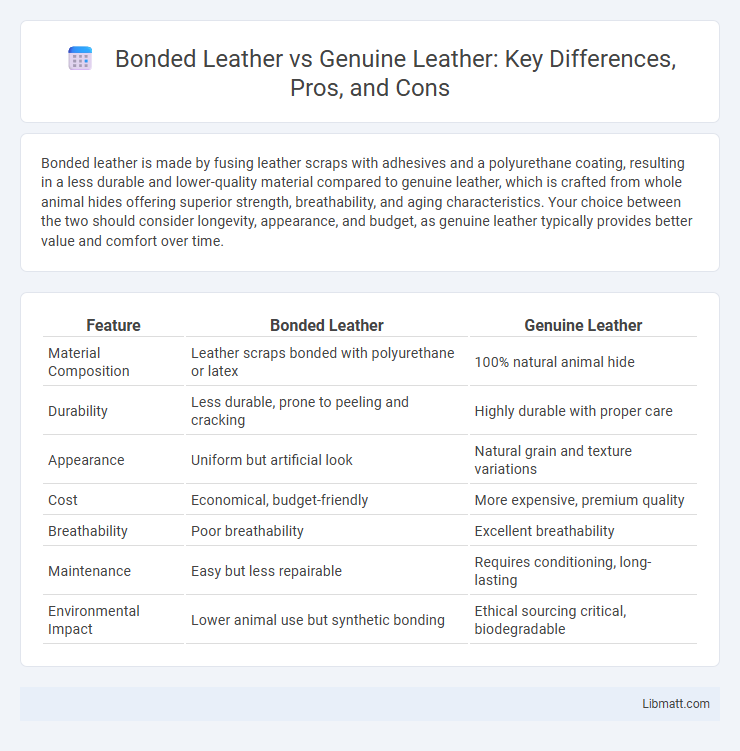Bonded leather is made by fusing leather scraps with adhesives and a polyurethane coating, resulting in a less durable and lower-quality material compared to genuine leather, which is crafted from whole animal hides offering superior strength, breathability, and aging characteristics. Your choice between the two should consider longevity, appearance, and budget, as genuine leather typically provides better value and comfort over time.
Table of Comparison
| Feature | Bonded Leather | Genuine Leather |
|---|---|---|
| Material Composition | Leather scraps bonded with polyurethane or latex | 100% natural animal hide |
| Durability | Less durable, prone to peeling and cracking | Highly durable with proper care |
| Appearance | Uniform but artificial look | Natural grain and texture variations |
| Cost | Economical, budget-friendly | More expensive, premium quality |
| Breathability | Poor breathability | Excellent breathability |
| Maintenance | Easy but less repairable | Requires conditioning, long-lasting |
| Environmental Impact | Lower animal use but synthetic bonding | Ethical sourcing critical, biodegradable |
Understanding Bonded Leather
Bonded leather consists of shredded leather fibers mixed with a polyurethane or latex backing, offering a cost-effective alternative to genuine leather. It has a consistent appearance but lacks the durability and natural texture of genuine leather, which is made from whole animal hides. Your choice depends on budget and how much you value the authentic feel and longevity of genuine leather products.
What Is Genuine Leather?
Genuine leather is a natural material made from the hide of animals, primarily cows, that undergoes tanning and finishing processes to enhance durability and appearance. It retains the original grain and texture of the animal hide, offering breathability, strength, and a unique patina that improves with age. Understanding genuine leather helps you make informed choices about quality and longevity compared to alternatives like bonded leather.
How Bonded Leather Is Made
Bonded leather is produced by shredding genuine leather scraps and fibers, which are then combined with a polyurethane or latex binding material and pressed onto a fiber backing to create a uniform surface. This manufacturing process allows bonded leather to replicate the appearance of genuine leather while being more cost-effective. Your choice between bonded and genuine leather may depend on the material's durability, texture, and price point.
The Manufacturing Process of Genuine Leather
Genuine leather undergoes a meticulous manufacturing process that begins with selecting high-quality animal hides, primarily from cows. These hides are cleaned, tanned using vegetable or chrome methods, and then dyed to enhance durability and appearance. You receive a product that retains the natural grain and strength of the leather, providing long-lasting quality compared to bonded leather, which is made from reconstituted leather fibers.
Appearance and Texture Differences
Bonded leather features a surface made from leather scraps bonded together with polyurethane, resulting in a consistent texture but a less natural appearance compared to genuine leather. Genuine leather showcases unique grain patterns and natural imperfections, providing a richer, more authentic texture that improves with age. When choosing furniture or accessories, your preference for the tactile feel and visual depth of genuine leather versus the uniform look of bonded leather will influence your decision.
Durability: Bonded vs. Genuine Leather
Bonded leather typically consists of leather scraps bonded together with polyurethane or latex, resulting in lower durability compared to genuine leather, which is made from a single layer of animal hide. Genuine leather offers superior resistance to wear and tear, maintaining its appearance and structural integrity over time. Bonded leather tends to peel and crack faster under stress, making genuine leather the preferred choice for long-lasting furniture and accessories.
Cost Comparison: Which Is More Affordable?
Bonded leather is generally more affordable than genuine leather due to its manufacturing process that combines leather scraps with synthetic materials. Genuine leather commands a higher price because it is made from whole animal hides, offering greater durability and natural texture. Consumers seeking budget-friendly options often prefer bonded leather, while those prioritizing longevity and quality invest in genuine leather products.
Environmental Impact and Sustainability
Bonded leather, made from leather scraps bonded with adhesives, has a lower environmental impact due to utilizing waste materials, reducing leather landfill contributions. Genuine leather production involves animal farming, which contributes significantly to greenhouse gas emissions and water pollution, making it less sustainable. Choosing bonded leather can support your efforts towards eco-friendliness, but it often sacrifices durability compared to genuine leather.
Cleaning and Maintenance Tips
Bonded leather requires gentle cleaning with a damp cloth and mild soap to prevent peeling, avoiding harsh chemicals that can damage its surface. Genuine leather benefits from regular conditioning with leather-specific products to maintain suppleness and prevent cracking. Both materials should be kept away from direct sunlight and excessive moisture to prolong their lifespan and preserve appearance.
Which Leather Type Is Right for You?
Choosing between bonded leather and genuine leather depends on your priorities for durability, appearance, and budget. Genuine leather offers superior strength, natural texture, and longevity, making it ideal for furniture or accessories that endure frequent use, while bonded leather, made from leather scraps bonded with polyurethane, provides an affordable and eco-friendly option with a similar look but less resilience. Your decision should consider how often the item will be used and whether you prefer authentic material quality over cost savings.
Bonded leather vs genuine leather Infographic

 libmatt.com
libmatt.com